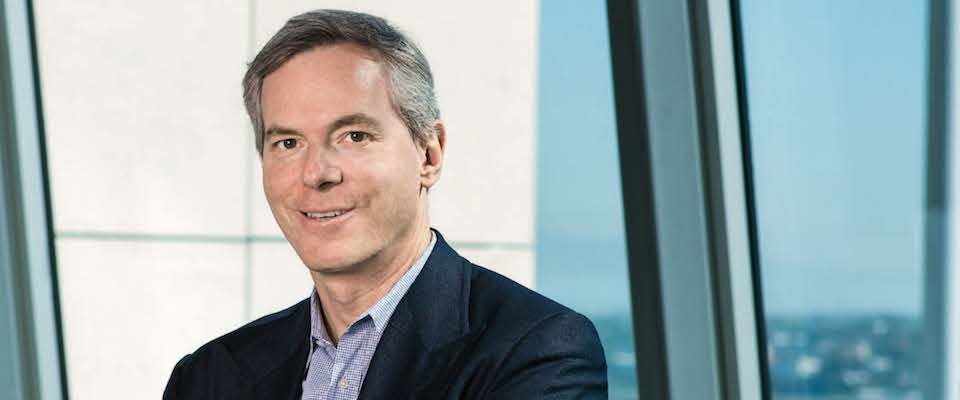Engineer and Qualcomm Executive Chairman Paul Jacobs is 2017 Alumnus of the Year.
At an age when most boys are learning to throw a curveball and struggling with elementary algebra, Paul Jacobs was writing code. Simple code, to be sure, but code good enough to let him play the video game Adventure with his dad on a clunky, early laptop.
It’s no surprise that Jacobs, who was in sixth or seventh grade when he wrote his first programs, grew up to be an engineer.
His father, Irwin Jacobs, was an engineer who brought electronic devices home to help his son learn about science. “I had the opportunity to see a lot of engineering when I was very young,” Jacobs recalled during a recent interview.
The elder Jacobs was a co-founder of Qualcomm, a San Diego–based, semiconductor design company that pioneered the development of modem chips that enabled cell phones to transmit data as well as voice. Decades later, Paul Jacobs succeeded his father and spent nine years running the company. Under his leadership, Qualcomm took on Intel, the world’s largest semiconductor company, and beat it in the burgeoning market for smartphone chips. Now he’s Qualcomm’s executive chairman, still playing a major role in the family business, but also focused on community involvement.
Paul Jacobs, Berkeley’s Alumnus of the Year for 2017, earned three degrees in electrical engineering from Cal (B.S. 1984, M.S. 1986, Ph.D. 1989), donated millions of dollars to the College of Engineering and the CITRIS Capital Projects Fund, endowed an engineering professorship, and served on a number of important University boards, including the Chancellor’s Executive Advisory Committee.
The most visible part of his legacy isn’t hard to spot. If you walk to the leafy, north rim of the campus you’ll see Jacobs Hall, a striking, three-story structure with expansive windows and outer walls clad with metallic siding.
The 24,000-square-foot building, which opened in 2015, was built with the help of a $20 million donation from the Jacobs family. It represents an important departure in engineering education, very much in the pattern of Jacobs himself.

“This tight integration of design and manufacturing in one setting is unusual in engineering education and mirrors operations in such high-tech industries as semiconductors, medical devices, and energy production and distribution,” wrote Shankar Shastry, dean of the College of Engineering, when he nominated Jacobs for the award.
Many of the students working in the building have rarely, if ever, attended an engineering class—and that’s by design. “We need students that balance engineering with human needs and arts,” says Bjorn Hartman, faculty director of the Jacobs Institute for Design Innovation, also a recipient of funding from the Paul and Stacy Jacobs Foundation.
The institute offers 22 courses a semester. Classes range from the quite technical, such as Processing of Material in Manufacturing, to ones designed for a broader segment of the campus like From Earth to Earth-Orbit to the Solar System and Beyond, which covers the past, present, and future of space exploration. More than 1,000 students take classes at Jacobs Hall each semester, including many liberal arts students, Hartman says.
On a recent afternoon at Jacobs Hall, Mane Chakarian, a senior psychology major, was using an oversized Epson printer to make a poster. “I really like to make stuff,” says Chakarian, who admitted—somewhat abashedly—that she had no idea who Paul Jacobs is. Another student, Ming Chen, a mechanical engineering major, was using a laser cutter to make lanterns for his sister’s wedding. Last year, he made a robot at the institute, he says.
Jacobs says he’d like to modify the familiar STEM acronym (science, technology, engineering, and mathematics). “I want to add the ‘A’—for arts—and make it STEAM,” he says, explaining that bringing liberal arts students into contact with engineers via the design institute broadens the worldview of both groups.
Jacobs describes himself as a tinkerer, and you can see a tinkerer’s mindset in the classrooms of Jacobs Hall. Some of the spacious, well-lit rooms have the kind of mechanical hoists and racks of hand tools you’d find in a machine shop, “It’s for students to come in and build things that look real. They work in teams that are not just engineers,” he says.
Being the boss’s son
Jacobs joined Qualcomm in 1990, six years after he earned his bachelor’s degree in engineering and computer science at Cal. He quickly learned that being the boss’s son can be a mixed blessing. “I found it strangely freeing. I felt like I could take a lot of risks. I wasn’t too worried if I did something that didn’t quite work I was going to get fired,” Jacob says.
Apple and Hewlett-Packard, the quintessential Silicon Valley startups, were founded in garages. Qualcomm, though, was founded in the den of Irwin Jacobs’s San Diego home in 1985.
But it also puts a lot of pressure on a young man to prove his own worth, let alone measure up to his father. That was doubly true at Qualcomm. Irwin Jacobs was an iconic industry figure who built a major company by defying conventional wisdom, says Nathan Brookwood, a longtime semiconductor analyst and founder of Insight64, a consultancy.
Apple and Hewlett-Packard, the quintessential Silicon Valley startups, were founded in garages. Qualcomm, though, was founded in the den of Irwin Jacobs’s San Diego home in 1985. At the time, the standard mobile communications technology was called GSM (global systems for mobile) but Jacobs and his six colleagues believed a technology called CDMA was a better bet, even though it was generally seen as too complex.
CDMA, which stands for code division mobile access, allows cellphone towers to transmit multiple calls at once by assigning each call its own encryption code. That’s a critical function for cell phone communications, but the Qualcomm team faced the proverbial chicken and egg dilemma. Telecommunications technologies need to be widely adopted to succeed, but someone has to accept the inherent risks of being first.
Qualcomm persisted and began licensing the technology to trucking companies that needed to track the location of their vehicles. In 1993, the U.S. Telecommunications Industry Association adopted CDMA technology as a standard, opening the door to wide-scale adoption—and a robust stream of licensing revenue.
Jacobs succeeded his father as CEO in 2005—just as it looked like Qualcomm was headed for a tumble. The newly minted chief executive had walked into an existential crisis, says Matt Grob, Qualcomm’s executive vice president for technology and a longtime friend of Jacobs.
The company was beset by legal and business disputes, with rivals suing over intellectual property and partners challenging licensing agreements.
“Paul never panicked,” says Grob. He quickly called an all-hands meeting and told the staff not to lose focus. He began a grueling series of trips to reassure customers and establish Qualcomm as a solid partner, “not just a tax collector.” (This is a pejorative term that rivals often use to describe companies that license technology to other companies.)
Crisis averted, Jacobs turned to expanding the company’s reach. He understood key technological trends in the industry, and almost as important, he understood the business model needed for success, says Brookwood.
“Sometimes the son of a founder is not quite up to the founder when he gets to run the business, but Paul really earned his stripes.”
Qualcomm began using more advanced methods to build systems for mobile devices. Rather than assembling a collection of chips to handle various internal chores, Qualcomm began integrating functions onto a single chip. That process reduced costs and won the business of major wireless carriers, a notoriously margin-conscious bunch, Brookwood says.
Jacobs had the vision to understand that graphics would become important to cell phone users and he pushed the industry toward LTE, the high-speed technology that succeeded relatively slow 3G and is used today by all the major carriers.
Qualcomm’s push into the smartphone era confounded Intel, which to this day lags behind Qualcomm and other mobile chip vendors, Brookwood says. “Sometimes the son of a founder is not quite up to the founder when he gets to run the business, but Paul really earned his stripes.”
Being the young son of the boss led some to underestimate him, Jacobs says. “I’d walk into the room and people would say ‘Oh, that’s the kid.’ That meant they were underestimating [me]. If you’re in a business situation and the other side is underestimating you, you actually have an advantage.”
A compass, not a map
Jacobs did earn his CEO stripes, but not by imitating his father. Qualcomm was always known as an engineering-driven culture, and in that respect it didn’t change when the younger Jacobs took over. But he did develop his own management style, and discussing this topic with him is a bit like attending a management seminar.

Like many founders, Irwin Jacobs was used to making all the decisions as CEO. “I knew that wouldn’t [work] for me,” Paul Jacobs says. But creating a less hierarchical decision-making culture was a difficult transition process for some employees. “People wanted to pass the buck. It took a while for people to get used to me insisting that they make decisions.”
And some of them had to leave. But those who stayed, he says, were now working for a boss whose management philosophy is that ideas should float up from the bottom as well as flow down from the top, and that wisdom is not confined to the corner office. “As a leader, my job is to give them a compass and not a map,” he says. “I need to know enough so I know they are doing the right thing, but I don’t need to know enough to do their job.” As Qualcomm grew it became apparent that the company needed to broaden its vision beyond the basics of digital communications. “I said the phone will be the most important thing in your life and that the wireless internet is going to be bigger than the Internet,” Jacobs says. “I changed the company’s perception of itself.”
And he was ahead of his time in understanding that video would become important on mobile devices; Qualcomm even made an early attempt at a video service. It didn’t succeed, but it showed that the company was moving in the right direction. “That was something,” says Grob, “that Irwin would not have done.”
While Paul Jacobs believes he had the right vision, he admits that Qualcomm’s execution wasn’t always the best. Mobile platforms need independent developers to write applications because without compelling applications there is no reason to use the platform. At one point, Qualcomm was charging developers to write those applications, a policy that encouraged them to abandon Qualcomm and work for the competition. “That was a dumb decision,” Jacobs acknowledges.
From skis to satellites
At 54, Jacobs looks fit. His preferred recreation is mogul skiing, a sport, he says, that helps him focus on the present instead of the future.
“When you’re skiing moguls, your whole perception is focused on two bumps ahead of you. Not three, not the one at your feet. If you don’t, you’ll wipe out and that forces you into the moment. It’s a very Zenish thing,” he says.
He also gets some exercise keeping up with his youngest daughter, a toddler, born to Jacobs and his second wife, Geneviève, in 2016. His earlier marriage, to Stacy Jacobs (’84 B.A. in physiology, ’87 B.S. in optometry, and ’89 O.D.), produced three children but ended after nearly 22 years. Jacobs prefers not to see the names of his children in print and chose to sit for an interview in a conference room, rather than his office, to better protect the personal privacy he greatly values.
Jacobs did say, though, that he regrets not spending more time with his older children because of the pressure of business. His current position as Qualcomm’s chairman, however, will allow him more family time, he says.
As befits a second-generation engineer, his reading tends to be rather technical. His favorite book is The Fabric of Reality, by physicist David Deutsch, about quantum mechanics and its relationship to reality.
Books about management aren’t usually on his reading list. “I learned on the job. The school of hard knocks is an expensive school,” he says. “We went to that expensive school.”
Jacobs relinquished the CEO spot to longtime Qualcomm exec Steve Mollenkopf in 2014. He’s now executive chairman, a job he relishes. “If I were offered the CEO job again, I wouldn’t take it,” says Jacobs. He says he is happy not to deal with the operational details of running a major company, and instead likes focusing on identifying future directions for Qualcomm.
One new direction pushed by Jacobs as chairman: Satellites. Qualcomm is a key partner in OneWeb, a startup that hopes to launch a fleet of low-Earth-orbit satellites to provide Internet access to unserved parts of the globe. It’s already a serious venture. Japanese software giant SoftBank owns 20 percent of OneWeb and board members include Richard Branson, founder of the Virgin Group, Thomas Enders, CEO of Airbus Group, and Jacobs.
As busy as his job keeps him, Jacobs finds time for a large number of civic and charitable functions, ranging from the board of San Diego’s Museum of Contemporary Art, to the Global eHealth Foundation, and FIRST, a nonprofit educational venture aimed at bolstering STEM education for children.
But during our interview, Jacobs sounded most enthusiastic when he discussed his ties to Cal and the Jacobs Institute for Design Innovation. He grew up in La Jolla, in a home with his parents, Irwin and Joan, and his brothers Hal, Jeff ’88, and Gary. He describes the community he was raised in as being “pretty manicured,” and says he wanted to experience a more heterogeneous environment and “exposure to the People’s Republic of Berkeley.” So he opted for Cal over Stanford. That choice, he says, shaped his career and his life. “I believe that education comes from diversity and getting ideas that are not just your own. That created the business person and the engineer and the human being that I am.”
Bill Snyder is a regular contributor to California and California Online. He has followed business, technology, and the business of technology for nearly 25 years at newspapers, national magazines, and websites.




















